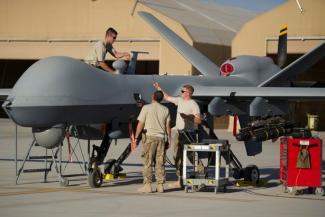Military affairs
War technologically transformed
 Cloys/ZUMA Press/picture-alliance
Cloys/ZUMA Press/picture-alliance
Many scholars perceive conflicts as a disruption of the globalisation processes, but Teresa Koloma Beck of Berlin’s Humboldt University Berlin disagrees. She argues that, in the eyes of local people, it is the other way round. When international forces intervene, local people are suddenly confronted with foreign troops and organisations.
According to Beck, context matters. In Angola, for example, international intervention was conducted in a post-conflict setting with the goal of peacekeeping. Beck has observed that it fostered a positive notion of globalisation. In contrast, when a military intervention is supposed to stop an on-going conflict, the impact may be an escalation of violence, and the people affected will resent the foreign forces. Beck considers Afghanistan an example, and argues that the globalised world is often experienced as a system of hierarchy and asymmetry. Because of the tense security situation, members of the international forces stay segregated from the local people, compounding the problems.
States used to be the main actors in classical wars, but according to Conrad Schetter of the Bonn International Center for Conversion (BICC), conflict parties increasingly rely on networks. In the era of globalisation and the internet, propaganda is becoming ever more important, especially in social-media networks. Legitimacy in the eyes of the public is an important resource.
After the unsuccessful and costly interventions in Afghanistan and Iraq, western governments are now shying away from deploying ground forces in conflict-torn countries, as Max Mutschler of BICC points out. Their citizens don’t want countrymen to die in war, especially as the strategic goals are typically not achieved.
Accordingly, the fight against ISIS in Iraq and Syria is conducted with air and drone strikes today. Military interventions are undergoing a technological transformation, with robots replacing human beings. Niklas Schörning of the Peace Research Institute Frankfurt (PRIF) says that a growing number of countries possess military robots. These gadgets allow them to conduct war from a distance and reduce casualties among their own troops. According to him, non-state groups have begun to use short-range handicraft-style drones, which are technologically less advanced than those of regular armies, but devastating nonetheless. Simplified drone technology thus provides a cheap means for non-state groups to attack state opponents.
At a BICC-organised conference in Bonn in October, Schörning warned that “unmanned warfare” may lead to an “era of clandestine intervention”. He calls for stricter rules and criteria regarding the use of unmanned systems. Robots and drones can decouple modern warfare from geographical dimensions and distract public attention, as citizens tend to worry most about the safety of their nation’s soldiers.
When there are “no boots on the ground”, moreover, the abuse of civilian people’s rights and the need for humanitarian action often stay unnoticed. The latest example of important global media attention is Madaya. This Syrian town is besieged and people were starving. After their suffering attracted global attention, a humanitarian mission became possible since conflict parties worry about their public image.
Floreana Miesen